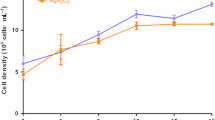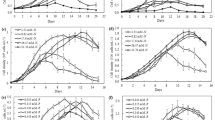Abstract
Nitrogen and phosphorous are important nutritional regulators for the growth of cyanobacteria, thereby having a significant impact in bloom formation by toxic species. Usage of toxic cyanobacteria for increasing valuable metabolite production by nutrient manipulation is still unexplored. Hence, the current work is aimed to estimate and compare growth, pigment, and increased lipid production coupled with the identification of fatty acids between two toxic strains—Anabaena circinalis FSS 124 and Cylindrospermopsis raciborskii FSS 127 under various combinations of these two nutrients. Low level of nitrogen and phosphorous enhanced lipid content in both strains (˃ 20% and 30% respectively) and C. raciborskii, respectively. Lipid productivity in low phosphorous concentration (P0.5) was achieved significantly high in C. raciborskii. Similarly, a substantial amount of carotenoids was obtained at reduced nitrogen and phosphorous in C. raciborskii accompanied by lessened growth and Chl a concentration. Unlikely, enough biomass (˃ 2 g L−1) was produced at high nutrient levels in both species. Comparative statistical significance (p < 0.05) was found between two species regarding biomass production, chlorophyll concentration, lipid content, and productivity and between these factors in each species under both nutrient variations. FAME of Cylindrospermopsis is composed of saturated fatty acids (˃ 50%) and MUFA (˃ 25%) while Anabaena contains PUFA (˃ 21%) additionally. However, the study highlights C. raciborskii as potential lipid and carotenoid producer at nutrient stress and finds a novel way to utilize these cyanobacterial biomasses, which cause immense environmental hazards and life threats.



Similar content being viewed by others
References
Baker L, Sendall BC, Gasser RB, Menjivar T, Neilan BA, Jex AR (2013) Rapid, multiplex-tandem PCR assay for automated detection and differentiation of toxigenic cyanobacterial blooms. Mol Cell Probes 27:208–214. https://doi.org/10.1016/j.mcp.2013.07.001
Belotti G, Bravi M, Caprariis BD, Filippis PD, Scarsella M (2013) Effect of nitrogen and phosphorus starvations on Chlorella vulgaris lipids productivity and quality under different trophic regimens for biodiesel production. Am J Plant Sci 4:44–51. https://doi.org/10.4236/ajps.2013.412a2006
Bligh EG, Dyer WJ (1959) A rapid method of total lipid extraction and purification. Can J Biochem Physiol 37:911–917. https://doi.org/10.1139/o59-099
Bolch SI, Blackburn CJS (1996) Isolation and purification of Australian isolates of the toxic cyanobacterium Microcystis aeruginosa. Kutz J Appl Phycol 8:5–13. https://doi.org/10.1007/BF02186215
Breuer G, Lamers PP, Martens DE, Draaisma RB, Wijffelsa RH (2012) The impact of nitrogen starvation on the dynamics of triacylglycerol accumulation in nine microalgae strains. Bioresour Technol 124:217–226. https://doi.org/10.1016/j.biortech.2012
Carmichael W (2001) Health effects of toxin-producing cyanobacteria: “The CyanoHABs.”. Hum Ecol Risk Assess An Int J 7:1393–1407. https://doi.org/10.1080/20018091095087
Cheng Y, Zheng Y, Jean S, Gheynst V (2011) Rapid quantitative analysis of lipids using a colorimetric method in a microplate format. Lipids 46:95–103. https://doi.org/10.1007/s11745-010-3494-0
Ernst A, Deicher M, Herman PMJ, Wollenzien UIA (2005) Nitrate and phosphate affect cultivability of cyanobacteria from environments with low nutrient levels. Appl Environ Microbiol 71:3379–3383. https://doi.org/10.1128/AEM.71.6.3379-3383.2005
Fan J, Xu H, Luo Y, Wan M, Huang J, Wang W, Li Y (2015) Impacts of CO2 concentration on growth, lipid accumulation, and carbon-concentrating-mechanism-related gene expression in oleaginous Chlorella. Appl Microbiol Biotechnol 99:2451–2462. https://doi.org/10.1007/s00253-015-6397-4
Fu L, Li Q, Yan G, Zhou D, Crittenden JC (2019) Hormesis effects of phosphorus on the viability of Chlorella regularis cells under nitrogen limitation. Biotechnol Biofuels 12:1–9. https://doi.org/10.1186/s13068-019-1458-z
George B, Pancha I, Desai C, Chokshi K, Paliwal C, Ghosh T, Mishra S (2014) Effects of different media composition, light intensity and photoperiod on morphology and physiology of freshwater microalgae Ankistrodesmus falcatus - a potential strain for bio-fuel production. Bioresour Technol 171:367–374. https://doi.org/10.1016/j.biortech.2014.08.086
Guillard RRL, Ryther JH (1962) Studies on marine planktonic diatoms I. Cyclotella nana Hustedt and Detonula confervcea (Cleve) Gran. can. Can J Microbiol 8:229–239. https://doi.org/10.1139/m62-029
Hamilton DP, Salmaso N, Paerl HW (2016) Mitigating harmful cyanobacterial blooms: strategies for control of nitrogen and phosphorus loads. Aquat Ecol 50:351–366. https://doi.org/10.1007/s10452-016-9594-z
Herrero AAM, Muro-Pastor, Flores E (2001) Nitrogen control in cyanobacteria. J Bacteriol 183:411–425. https://doi.org/10.1128/jb.183.2.411-425.2001
Ho SH, ChenYD CCY, Lai YY, Chen CY, Kondo A, Ren NQ, Chang JS (2017) Feasibility of CO2 mitigation and carbohydrate production by microalga Scenedesmus obliquus CNW-N used for bioethanol fermentation under outdoor conditions: effects of seasonal changes. Biotechnol Biofuels 10:1–13. https://doi.org/10.1186/s13068-017-0712-5
Ho S, Lai YY, Chiang CY, Chen CNN, Chang JS (2013) Selection of elite microalgae for biodiesel production in tropical conditions using a standardized platform. Bioresour Technol 147:135–142. https://doi.org/10.1016/j.biortech.2013.08.028
Huergo LF, Dixon R (2015) The emergence of 2-oxoglutarate as a master regulator metabolite. Microbiol Mol Biol Rev 79:419–435. https://doi.org/10.1128/MMBR.00038-15
Huisman J, Codd GA, Paerl HW, Ibelings BW, Verspagen JMH, Visser PM (2018) Cyanobacterial blooms. Nat Rev Microbiol 16:471–483. https://doi.org/10.1038/s41579-018-0040-1
Isvánovics V, Shafik HM, Présing M, Juhos S (2000) Growth and phosphate uptake kinetics of the cyanobacterium, Cylindrospermopsis raciborskii (Cyanophyceae) in throughflow cultures. Freshw Biol 43:257–275. https://doi.org/10.2216/05-58.1
Kamalanathan M, Gleadow R, Beardall J (2015) Impacts of phosphorus availability on lipid production by Chlamydomonas reinhardtii. Algal Res 12:191–196. https://doi.org/10.1016/j.algal.2015.08.021
Kenesi G, Shafik HM, Kovac’s AW, Herodek S, Pre’sing M (2009) Effect of nitrogen forms on growth, cell composition and N2 fixation of Cylindrospermopsis raciborskii in phosphoruslimited chemostat cultures. Hydrobiologia 623:191–202. https://doi.org/10.1007/s10750-008-9657-9
Kim ZH, Park H, Hong SJ, Lim SM, Lee CG (2016) Development of a floating photobioreactor with internal partitions for efficient utilization of ocean wave into improved mass transfer and algal culture mixing. Bioprocess Biosyst Eng 39:713–723. https://doi.org/10.1007/s00449-016-1552-6
Knothe G, Dunn RO, Bagby MO (1997) Biodiesel: the use of vegetable oils and their derivatives as alternative diesel fuels. In: Saha BC, Woodward J (eds) Fuels and Chemicals from Biomass, 666th edn. ACS symposium series, Washington, pp 172–208
Krzemińska I, Oleszek M (2016) Glucose supplementation-induced changes in the Auxenochlorella protothecoides fatty acid composition suitable for biodiesel production. Bioresour Technol 218:1294–1297. https://doi.org/10.1016/j.biortech.2016.07.104
Lichtenthaler HK (1987) Chlorophylls and carotenoids: Pigments of photosynthetic biomembranes. Methods Enzymol 148:350–382. https://doi.org/10.1016/0076-6879(87)48036-1
Markou G, Vandamme D, Muylaert K (2014) Microalgal and cyanobacterial cultivation: the supply of nutrients. Water Res 65:186–202. https://doi.org/10.1016/j.watres.2014.07.025
Matos ÂP, Feller R, Moecke EHS, Sant’Anna ES (2015) Biomass, lipid productivities and fatty acids composition of marine Nannochloropsis gaditana cultured in desalination concentrate. Bioresour Technol 197:48–55. https://doi.org/10.1016/j.biortech.2015.08.041
Mishra SK, Suh WI, Farooq W, Moon M, Shrivastav A, Park MS, Yang J (2014) Rapid quantification of microalgal lipids in aqueous medium by a simple colorimetric method. Bioresour Technol 155:330–333. https://doi.org/10.1016/j.biortech.2013.12.077
Moisander PH, Cheshire LA, Braddy J, Calandrino ES, Hoffman M, Piehler MF, Paerl HW (2012) Facultative diazotrophy increases Cylindrospermopsis raciborskii competitiveness under fluctuating nitrogen availability. FEMS Microbiol Ecol 79(3):800–811. https://doi.org/10.1111/j.1574-6941.2011.01264.x
O’Neil JM, Davis TW, Burford MA, Gobler CJ (2012) The rise of harmful cyanobacteria blooms: potential role of eutrophication and climate change. Harmful Algae 14:313–334. https://doi.org/10.1016/j.hal.2011.10.027
Paerl HW, Huisman J (2009) Climate change: a catalyst for global expansion of harmful cyanobacterial blooms. Environ Microbiol Rep 1:27–37. https://doi.org/10.1111/j.1758-2229.2008.00004.x
Pereyra JPA, D’Agostino PM, Mazmouz R, Woodhouse JN, Pickford R, Jameson I, Neilan BA (2017) Molecular and morphological survey of saxitoxin-producing cyanobacterium Dolichospermum circinale (Anabaena circinalis) isolated from geographically distinct regions of Australia. Toxicon 138:68–77. https://doi.org/10.1016/j.toxicon.2017.08.006
Ranganathan BV, Ravikumar R (2018) Screening of microalgae for treating Garcinia cambogia wash water with potential lipid production. Environ Sci Pollut Res 26:34685–34692. https://doi.org/10.1007/s11356-018-2597-7
Ren X, Chen J, Deschênes JS, Tremblay R, Jolicoeur M (2016) Glucose feeding recalibrates carbon flux distribution and favours lipid accumulation in Chlorella protothecoides through cell energetic management. Algal Res 14:83–91. https://doi.org/10.1016/j.algal.2016.01.004
Rhiel E, Krupinska K, Wehrmeyer W (1986) Effects of nitrogen starvation on the function and organization of the photosynthetic membranes in Cryptomonas maculata (Cryptophyceae). Planta 169:361–369. https://doi.org/10.1007/BF00392132
Sahin MS, Khazi MI, Demirel Z, Dalay MC (2019) Variation in growth, fucoxanthin, fatty acids profile and lipid content of marine diatoms Nitzschia sp. and Nanofrustulum shiloi in response to nitrogen and iron. Biocatal Agric Biotechnol 17:390–398. https://doi.org/10.1016/j.bcab.2018.12.023
Sharma AK, Sahoo PK, Singhal S, Patel A (2016) Impact of various media and organic carbon sources on biofuel production potential from Chlorella spp. 3 Biotech 6:116. https://doi.org/10.1007/s13205-016-0434-6
Stewart I, Carmichael WW, Sadler R, McGregor GB, Reardon K, Eaglesham GK et al (2009) Occupational and environmental hazard assessments for the isolation, purification and toxicity testing of cyanobacterial toxins. Environ Health 8:52. https://doi.org/10.1186/1476-069X-8-52
Sun XM, Ren LJ, Zhao QY, Xiao-Jun Ji XJ, Huang H (2018) Microalgae for the production of lipid and carotenoids: a review with focus on stress regulation and adaptation. Biotechnol Biofuels 11:1–16. https://doi.org/10.1186/s13068-018-1275-9
Wang S, Xiao J, Wan L, Zhou Z, Wang Z, Song C, Zhou Y, Cao X (2018) Mutual dependence of nitrogen and phosphorus as key nutrient elements: one facilitates Dolichospermum flos-aquae to overcome limitation by the other. Environ Sci Technol 52:5653–5661. https://doi.org/10.1021/acs.est.7b04992
Wellburn AR (1994) The spectral determination of Chlorophylls a and b, as well as total carotenoids, using various solvents with spectrophotometers of different resolution. J Plant Physiol 144:307–313. https://doi.org/10.1016/S0176-1617(11)81192-2
Willis A, Adams MP, Ann W, Chuang AW, Orra PT, O’Brien KR, Burford MA (2015) Constitutive toxin production under various nitrogen and phosphorus regimes of three ecotypes of Cylindrospermopsis raciborskii ((Wołoszyńska) Seenayya et Subba Raju). Harmful Algae 47:27–34. https://doi.org/10.1016/j.hal.2015.05.011
Yang F, Xiang W, Li T, Long L (2018) Transcriptome analysis for phosphorus starvation-induced lipid accumulation in Scenedesmus sp. Sci Reports Nat 8:1–11. https://doi.org/10.1038/s41598-018-34650-x
Yang Y, Jiang Y, Li X, Li H, Chen Y, Xie J, Cai F, Li R (2016) Variations of growth and toxin yield in Cylindrospermopsis raciborskii under different phosphorus concentrations. Toxins (Basel) 9:1–15. https://doi.org/10.3390/toxins9010013
Zavřel T, Sinetova MA, Červený J (2015) Measurement of Chlorophyll a and carotenoids concentration in cyanobacteria. Bio-Protocol 5:e1467. https://doi.org/10.21769/BioProtoc.1467
Zhang P, Li Z, Lu L, Xiao Y, Liu J, Guo J, Fang F (2017) Effects of stepwise nitrogen depletion on carotenoid content, fluorescence parameters and the cellular stoichiometry of Chlorella vulgaris. Spectrochim Acta Part A Mol Biomol Spectrosc 181:30–38. https://doi.org/10.1016/j.saa.2017.03.022
Zhao LS, Li K, Wang QM, Song XY, Su HN, Xie BB, Zhang XY, Huang F, Chen XL, Zhou BC, Zhang YZ (2017) Nitrogen starvation impacts the photosynthetic performance of Porphyridium cruentum as revealed by chlorophyll a fluorescence. Sci Reports Nat 7:1–11. https://doi.org/10.1038/s41598-017-08428-6
Acknowledgments
We thank Ms. Cathy Johnston, Manager, Australian National Algae Supply Service (CSIRO, Tasmania) for providing the strains. The GCMS analysis of FAME was facilitated by SAIF, VIT University, Vellore, Tamil Nadu, India.
Author information
Authors and Affiliations
Contributions
AS and RR devised and planned the experiments; AS performed the experiments; AS and RBV analyzed and interpreted the results; RR supervised the whole project; AS and RBV prepared the figures and tables; AS wrote the manuscript; all the authors reviewed and commented on the manuscript; AS edited the manuscript; all authors read and approved the final manuscript.
Corresponding author
Ethics declarations
Competing interests
The authors declare that they have no competing interests.
Additional information
Responsible Editor: Vitor Manuel Oliveira Vasconcelos
Publisher’s note
Springer Nature remains neutral with regard to jurisdictional claims in published maps and institutional affiliations.
Rights and permissions
About this article
Cite this article
Sarkar, A., Rajarathinam, R. & Venkateshan, R.B. A comparative assessment of growth, pigment and enhanced lipid production by two toxic freshwater cyanobacteria Anabaena circinalis FSS 124 and Cylindrospermopsis raciborskii FSS 127 under various combinations of nitrogen and phosphorous inputs. Environ Sci Pollut Res 28, 15923–15933 (2021). https://doi.org/10.1007/s11356-020-11754-4
Received:
Accepted:
Published:
Issue Date:
DOI: https://doi.org/10.1007/s11356-020-11754-4




